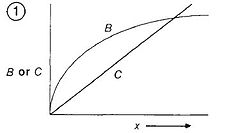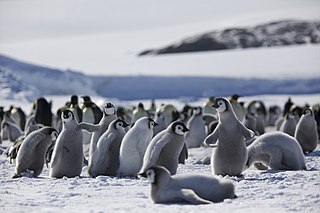
Behavioral ecology, also spelled behavioural ecology, is the study of the evolutionary basis for animal behavior due to ecological pressures. Behavioral ecology emerged from ethology after Niko Tinbergen outlined four questions to address when studying animal behaviors: What are the proximate causes, ontogeny, survival value, and phylogeny of a behavior?

Foraging is searching for wild food resources. It affects an animal's fitness because it plays an important role in an animal's ability to survive and reproduce. Foraging theory is a branch of behavioral ecology that studies the foraging behavior of animals in response to the environment where the animal lives.
The marginal value theorem (MVT) is an optimality model that usually describes the behavior of an optimally foraging individual in a system where resources are located in discrete patches separated by areas with no resources. Due to the resource-free space, animals must spend time traveling between patches. The MVT can also be applied to other situations in which organisms face diminishing returns.

Optimal foraging theory (OFT) is a behavioral ecology model that helps predict how an animal behaves when searching for food. Although obtaining food provides the animal with energy, searching for and capturing the food require both energy and time. To maximize fitness, an animal adopts a foraging strategy that provides the most benefit (energy) for the lowest cost, maximizing the net energy gained. OFT helps predict the best strategy that an animal can use to achieve this goal.
Human behavioral ecology (HBE) or human evolutionary ecology applies the principles of evolutionary theory and optimization to the study of human behavioral and cultural diversity. HBE examines the adaptive design of traits, behaviors, and life histories of humans in an ecological context. One aim of modern human behavioral ecology is to determine how ecological and social factors influence and shape behavioral flexibility within and between human populations. Among other things, HBE attempts to explain variation in human behavior as adaptive solutions to the competing life-history demands of growth, development, reproduction, parental care, and mate acquisition. HBE overlaps with evolutionary psychology, human or cultural ecology, and decision theory. It is most prominent in disciplines such as anthropology and psychology where human evolution is considered relevant for a holistic understanding of human behavior.
Life history theory is an analytical framework designed to study the diversity of life history strategies used by different organisms throughout the world, as well as the causes and results of the variation in their life cycles. It is a theory of biological evolution that seeks to explain aspects of organisms' anatomy and behavior by reference to the way that their life histories—including their reproductive development and behaviors, post-reproductive behaviors, and lifespan —have been shaped by natural selection. A life history strategy is the "age- and stage-specific patterns" and timing of events that make up an organism's life, such as birth, weaning, maturation, death, etc. These events, notably juvenile development, age of sexual maturity, first reproduction, number of offspring and level of parental investment, senescence and death, depend on the physical and ecological environment of the organism.
In ecology, an ideal free distribution (IFD) is a theoretical way in which a population's individuals distribute themselves among several patches of resources within their environment, in order to minimize resource competition and maximize fitness. The theory states that the number of individual animals that will aggregate in various patches is proportional to the amount of resources available in each. For example, if patch A contains twice as many resources as patch B, there will be twice as many individuals foraging in patch A as in patch B.
Cooperative breeding is a social system characterized by alloparental care: offspring receive care not only from their parents, but also from additional group members, often called helpers. Cooperative breeding encompasses a wide variety of group structures, from a breeding pair with helpers that are offspring from a previous season, to groups with multiple breeding males and females (polygynandry) and helpers that are the adult offspring of some but not all of the breeders in the group, to groups in which helpers sometimes achieve co-breeding status by producing their own offspring as part of the group's brood. Cooperative breeding occurs across taxonomic groups including birds, mammals, fish, and insects.

Mate choice is one of the primary mechanisms under which evolution can occur. It is characterized by a "selective response by animals to particular stimuli" which can be observed as behavior. In other words, before an animal engages with a potential mate, they first evaluate various aspects of that mate which are indicative of quality—such as the resources or phenotypes they have—and evaluate whether or not those particular trait(s) are somehow beneficial to them. The evaluation will then incur a response of some sort.
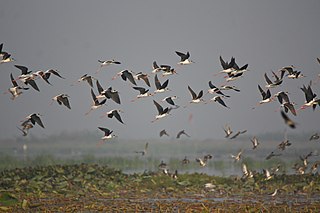
A flock is a gathering of individual birds to forage or travel collectively. Avian flocks are typically associated with migration. Flocking also offers foraging benefits and protection from predators, although flocking can have costs for individual members.

The sexy son hypothesis in evolutionary biology and sexual selection, proposed by Patrick J. Weatherhead and Raleigh J. Robertson of Queen's University in Kingston, Ontario in 1979, states that a female's ideal mate choice among potential mates is one whose genes will produce males with the best chance of reproductive success. This implies that other benefits the father can offer the mother or offspring are less relevant than they may appear, including his capacity as a parental caregiver, territory and any nuptial gifts. Fisher's principle means that the sex ratio is always near 1:1 between males and females, yet what matters most are her "sexy sons'" future breeding successes, more likely if they have a promiscuous father, in creating large numbers of offspring carrying copies of her genes. This sexual selection hypothesis has been researched in species such as the European pied flycatcher.
Mate desertion occurs when one or both parents abandon their current offspring, and thereby reduce or stop providing parental care. Often, by deserting, a parent attempts to increase breeding opportunities by seeking out another mate. This form of mating strategy behavior is exhibited in insects, birds and mammals. Typically, males are more likely to desert, but both males and females have been observed to practice mate desertion.

In ethology and behavioral ecology, trap-lining or traplining is a feeding strategy in which an individual visits food sources on a regular, repeatable sequence, much as trappers check their lines of traps. Traplining is usually seen in species foraging for floral resources. This involves a specified route in which the individual traverses in the same order repeatedly to check specific plants for flowers that hold nectar, even over long distances. Trap-lining has been described in several taxa, including bees, butterflies, tamarins, bats, rats, and hummingbirds and tropical fruit-eating mammals such as opossums, capuchins and kinkajous. Traplining is used to term the method in which bumblebees and hummingbirds go about collecting nectar, and consequently, pollinating each plant they visit. The term "traplining" was originally coined by Daniel Janzen, although the concept was discussed by Charles Darwin and Nikolaas Tinbergen.
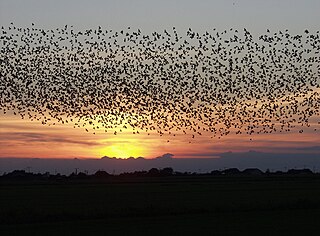
Collective animal behaviour is a form of social behavior involving the coordinated behavior of large groups of similar animals as well as emergent properties of these groups. This can include the costs and benefits of group membership, the transfer of information, decision-making process, locomotion and synchronization of the group. Studying the principles of collective animal behavior has relevance to human engineering problems through the philosophy of biomimetics. For instance, determining the rules by which an individual animal navigates relative to its neighbors in a group can lead to advances in the deployment and control of groups of swimming or flying micro-robots such as UAVs.
The sexual division of labour (SDL) is the delegation of different tasks between males and females. Among human foragers, males and females target different types of foods and share them with each other for a mutual or familial benefit. In some species, males and females eat slightly different foods, while in other species, males and females will routinely share food; but only in humans are these two attributes combined. The few remaining hunter-gatherer populations in the world serve as evolutionary models that can help explain the origin of the sexual division of labor. Many studies on the sexual division of labor have been conducted on hunter-gatherer populations, such as the Hadza, a hunter-gatherer population of Tanzania.
Interlocus sexual conflict is a type of sexual conflict that occurs through the interaction of a set of antagonistic alleles at two or more different loci, or the location of a gene on a chromosome, in males and females, resulting in the deviation of either or both sexes from the fitness optima for the traits. A co-evolutionary arms race is established between the sexes in which either sex evolves a set of antagonistic adaptations that is detrimental to the fitness of the other sex. The potential for reproductive success in one organism is strengthened while the fitness of the opposite sex is weakened. Interlocus sexual conflict can arise due to aspects of male–female interactions such as mating frequency, fertilization, relative parental effort, female remating behavior, and female reproductive rate.

Messor barbarus is a species of harvester ant in the subfamily Myrmicinae. It is found In Southern Europe and Northern Africa.

In behavioral ecology, polyandry is a class of mating system where one female mates with several males in a breeding season. Polyandry is often compared to the polygyny system based on the cost and benefits incurred by members of each sex. Polygyny is where one male mates with several females in a breeding season . A common example of polyandrous mating can be found in the field cricket of the invertebrate order Orthoptera. Polyandrous behavior is also prominent in many other insect species, including the red flour beetle and the species of spider Stegodyphus lineatus. Polyandry also occurs in some primates such as marmosets, mammal groups, the marsupial genus' Antechinus and bandicoots, around 1% of all bird species, such as jacanas and dunnocks, insects such as honeybees, and fish such as pipefish.
Evolutionary biologists have developed various theoretical models to explain the evolution of food-sharing behavior—"[d]efined as the unresisted transfer of food" from one food-motivated individual to another—among humans and other animals.
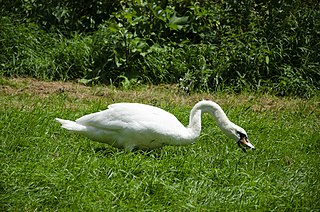
Avian foraging refers to the range of activities and behaviours exhibited by birds in their quest for food. In addition to their unique body adaptations, birds have a range of described behaviours that differ from the foraging behaviours of other animal groups. According to the foraging habitat, birds may be grouped into foraging guilds. Foraging includes a range of activities, starting with the search for food, making use of sensory abilities, and which may involve one or more birds either of a single or even of multiple species. This is followed by locomotion and movements to obtain or capture the food, followed by the processing or handling of the foods prior to ingestion. Like all organisms foraging entails balancing the energy spent and energy gained. The high metabolic rate of birds, among the highest in the homoeotherm groups, constrains them to ensure a net positive gain in energy and have led evolutionary ethologists to develop the idea of optimal foraging.
